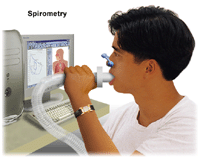Understanding Spirometry
Understanding Spirometry
To diagnose and check asthma, your healthcare provider examines you. He or she listens to your chest and asks you to breathe. You are asked questions about your symptoms, triggers, and any family history of asthma or allergies. Special lung function tests may also be done. One of these is a spirometry test.
Spirometry is an easy test. It tells your healthcare provider how well your lungs are working. The spirometer measures the amount of air you breathe out (exhale). It also measures how quickly you can exhale completely.
Spirometry is a recommended test for people with asthma. It can help with the following:
| What does it do? | When is it usually done? |
| It helps diagnose asthma. |
It may be used when your healthcare provider is making a diagnosis. |
| It determines a person’s response to treatment. |
It may be used after treatment is started and symptoms are more stable. |
| It can determine how severe asthma is. |
It may be used during worsening or severe episodes. |
| It is used to check asthma. |
It should be done at least every 1 to 2 years. |
What does the spirometer measure?
It can take a few different measures of your breath:
-
FVC (forced vital capacity). This is the total amount of air you exhale in a single, long breath.
-
FEV 1 (forced expiratory volume in one second). This is the amount of air you exhale in the first second.
-
FEV 1/FVC. This is the amount of air exhaled in the first second compared to the total amount of air exhaled. It’s given as a fraction or a percentage. In general, the higher the FEV 1/FVC, the better. Normal values depend on your age.
-
PEF (peak expiratory flow). This is a measure of how fast you can exhale. It can be tested with a spirometer or a peak flow meter.
Talk with your healthcare provider about your test results and what they mean. If you haven’t had a spirometry test in a year or two, ask your provider if you should have it done again.
Updated:
May 11, 2020
Reviewed By:
Alan J Blaivas DO,Amy Finke RN BSN,Daphne Pierce-Smith RN MSN CCRC
